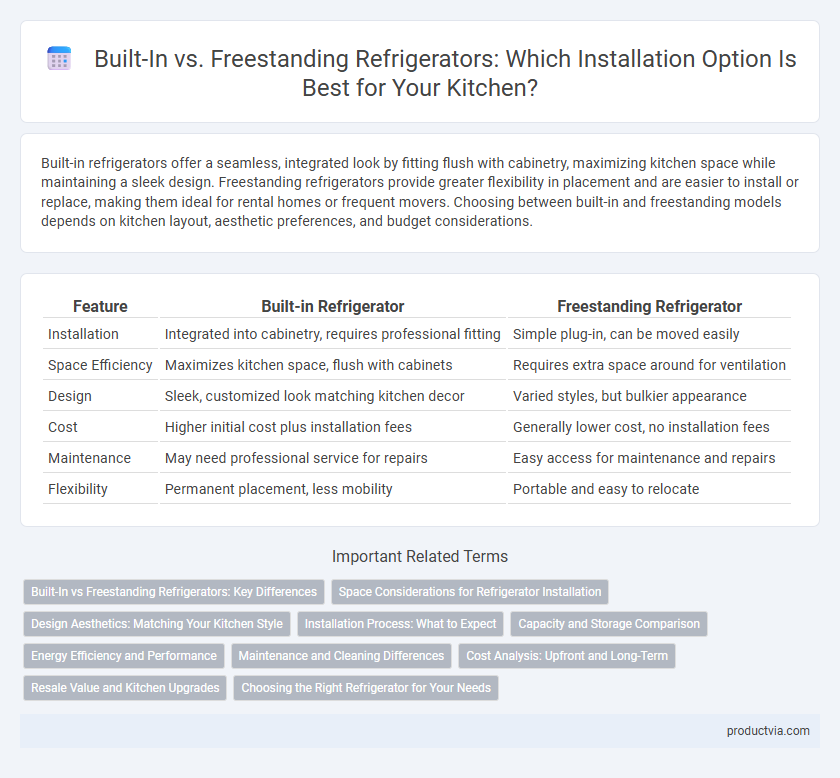Built-in refrigerators offer a seamless, integrated look by fitting flush with cabinetry, maximizing kitchen space while maintaining a sleek design. Freestanding refrigerators provide greater flexibility in placement and are easier to install or replace, making them ideal for rental homes or frequent movers. Choosing between built-in and freestanding models depends on kitchen layout, aesthetic preferences, and budget considerations.
Table of Comparison
| Feature | Built-in Refrigerator | Freestanding Refrigerator |
|---|---|---|
| Installation | Integrated into cabinetry, requires professional fitting | Simple plug-in, can be moved easily |
| Space Efficiency | Maximizes kitchen space, flush with cabinets | Requires extra space around for ventilation |
| Design | Sleek, customized look matching kitchen decor | Varied styles, but bulkier appearance |
| Cost | Higher initial cost plus installation fees | Generally lower cost, no installation fees |
| Maintenance | May need professional service for repairs | Easy access for maintenance and repairs |
| Flexibility | Permanent placement, less mobility | Portable and easy to relocate |
Built-In vs Freestanding Refrigerators: Key Differences
Built-in refrigerators are designed to integrate seamlessly with cabinetry, offering a flush, custom look and typically requiring professional installation, while freestanding refrigerators stand independently and offer more flexibility in placement. Built-in models generally have a higher price point and may feature specialized finishes to match kitchen designs, whereas freestanding units come in a wider range of sizes and styles, often at a more affordable cost. The choice between built-in and freestanding refrigerators impacts kitchen layout, installation complexity, and overall aesthetic appeal.
Space Considerations for Refrigerator Installation
Built-in refrigerators require precise measurements and integration within cabinetry, offering a streamlined and seamless kitchen design that maximizes space efficiency. Freestanding refrigerators provide flexibility in placement and are easier to install without the need for custom cabinetry, but they often require additional clearance around the appliance for ventilation and door swing. Considering kitchen layout, available space, and ventilation requirements is crucial to choose between built-in and freestanding refrigerator models for optimal functionality and aesthetics.
Design Aesthetics: Matching Your Kitchen Style
Built-in refrigerators provide a seamless, flush integration with cabinetry, enhancing modern kitchen aesthetics by maintaining clean lines and a streamlined appearance. Freestanding refrigerators offer greater flexibility in placement and come in various finishes, accommodating diverse kitchen styles but often standing out as a distinct appliance. Choosing between built-in and freestanding options depends on whether design cohesion or placement versatility is a priority in your kitchen layout.
Installation Process: What to Expect
Built-in refrigerators require precise measurements and custom cabinetry integration, involving professional installation for a seamless fit and ventilation management. Freestanding refrigerators offer simpler installation with minimal setup, typically only requiring placement near a power source and proper leveling. Expect built-in models to have longer installation times due to customization, while freestanding units provide quick and flexible placement options.
Capacity and Storage Comparison
Built-in refrigerators typically offer a streamlined design that integrates seamlessly with cabinetry, often providing slightly less interior capacity due to their built-in ventilation systems and framing requirements. Freestanding refrigerators generally deliver greater storage capacity and flexible placement options, allowing for larger models with more customizable shelf and bin configurations. Consumers prioritizing maximum storage volume and expandable arrangements often prefer freestanding units, while built-in models suit kitchens emphasizing a cohesive, space-saving aesthetic.
Energy Efficiency and Performance
Built-in refrigerators are designed for seamless integration into cabinetry, often providing superior insulation and energy efficiency compared to freestanding models due to tighter sealing and customized fit. Freestanding refrigerators offer more flexibility in placement but may have less optimized airflow and slightly higher energy consumption due to gaps around the unit. Energy Star ratings and compressor technology significantly influence overall performance and energy use regardless of installation type.
Maintenance and Cleaning Differences
Built-in refrigerators typically require more careful maintenance due to their flush installation, which limits airflow and access for cleaning behind and around the unit. Freestanding refrigerators offer easier cleaning with accessible sides and backs, allowing for simpler dust removal from coils and vents that improve efficiency. Proper maintenance of built-in models often involves professional servicing to ensure optimal airflow and prevent overheating, while freestanding units enable more straightforward user cleaning to maintain performance.
Cost Analysis: Upfront and Long-Term
Built-in refrigerators generally require a higher upfront investment due to customized cabinetry and professional installation costs, ranging from $3,000 to $10,000, compared to freestanding models, which typically cost between $500 and $2,000 with minimal installation fees. Long-term expenses for built-in units often include higher energy consumption and potential maintenance due to integrated components, whereas freestanding refrigerators tend to have lower operating and repair costs due to ease of access and standardized parts. Evaluating total cost of ownership involves balancing the premium paid initially for built-in aesthetics against the more economical and flexible freestanding option over time.
Resale Value and Kitchen Upgrades
Built-in refrigerators typically enhance resale value by offering a sleek, integrated appearance that appeals to buyers seeking modern kitchen upgrades. Freestanding refrigerators provide flexibility and are easier to replace, but may not deliver the same high-end aesthetic that boosts home value. Choosing built-in models can increase kitchen appeal and marketability during home sales.
Choosing the Right Refrigerator for Your Needs
Built-in refrigerators offer a sleek, integrated look that saves space and matches cabinetry, ideal for modern kitchens requiring seamless aesthetics. Freestanding refrigerators provide greater flexibility in placement and are generally easier to install, appealing to those who may move frequently or want a wider selection of sizes and styles. Selecting the right type depends on your kitchen layout, design preferences, and how you prioritize convenience versus customization.
Built-in vs Freestanding for Refrigerator Installation Infographic

 productvia.com
productvia.com